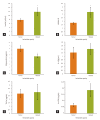Measurement of antioxidant capacity using the biological antioxidant potential test and its role as a predictive marker of metabolic syndrome
- PMID: 24574831
- PMCID: PMC3932393
- DOI: 10.3904/kjim.2014.29.1.31
Measurement of antioxidant capacity using the biological antioxidant potential test and its role as a predictive marker of metabolic syndrome
Abstract
Background/aims: Oxidative stress increases the risk of cardiovascular complications of metabolic syndrome (MetS). This study was conducted to examine the difference in antioxidant capacity according to the presence of MetS, and to characterize the association between antioxidant capacity and MetS-related factors.
Methods: We used the biological antioxidant potential (BAP) test to estimate antioxidant capacity. The BAP test has recently been used as an indicator of antioxidant capacity. We measured BAP levels in 45 patients with MetS (mean age, 44.6 ± 1.1 years) and 47 age- and sex-matched controls (mean age, 42.7 ± 1.1 years). To evaluate the association between antioxidant capacity and MetS, adiponectin, high-sensitivity C-reactive protein (hs-CRP), interleukin-6, tumor necrosis factor-α, and homeostatic model assessment for insulin resistance (HOMA-IR), linear regression and logistic analyses were performed.
Results: The mean BAP of the MetS group (1,937.3 ± 36.5 µmol/L) was significantly lower than that of the non-MetS group (2,101.7 ± 29.5 µmol/L). Also, the mean BAP was low in persons having low high density lipoprotein and high triglyceride. Reduced antioxidant capacity was significantly associated with adiponectin, HOMA-IR and hs-CRP after adjusting for age and sex. The odds ratios for MetS with BAP, log adiponectin, log HOMA-IR, and log hs-CRP were 0.63 (95% confidence interval [CI], 0.49 to 0.82), 0.22 (0.10 to 0.51), 14.24 (4.35 to 46.58), and 1.93 (1.36 to 2.75), respectively.
Conclusions: Persons with MetS showed reduced antioxidant capacity. We identified relationships between antioxidant capacity measured by BAP test and MetS, as well as MetS-related factors, such as insulin resistance, hs-CRP, and adiponectin.
Keywords: Adiponectin; Insulin; Metabolic syndrome; Oxidative stress.
Conflict of interest statement
No potential conflict of interest relevant to this article is reported.
Figures


Comment in
-
Oxidative stress, point-of-care test, and metabolic syndrome.Korean J Intern Med. 2014 Jan;29(1):20-2. doi: 10.3904/kjim.2014.29.1.20. Epub 2014 Jan 2. Korean J Intern Med. 2014. PMID: 24574828 Free PMC article. No abstract available.
References
-
- Ko KS, Rhee BD. Insulin resistance and metabolic syndrome. J Korean Diabetes Assoc. 2005;29:501–506.
-
- Mohamed-Ali V, Goodrick S, Rawesh A, et al. Subcutaneous adipose tissue releases interleukin-6, but not tumor necrosis factor-alpha, in vivo. J Clin Endocrinol Metab. 1997;82:4196–4200. - PubMed
-
- Hotamisligil GS, Shargill NS, Spiegelman BM. Adipose expression of tumor necrosis factor-alpha: direct role in obesity-linked insulin resistance. Science. 1993;259:87–91. - PubMed
Publication types
MeSH terms
Substances
LinkOut - more resources
Full Text Sources
Other Literature Sources
Medical
Research Materials
Miscellaneous
